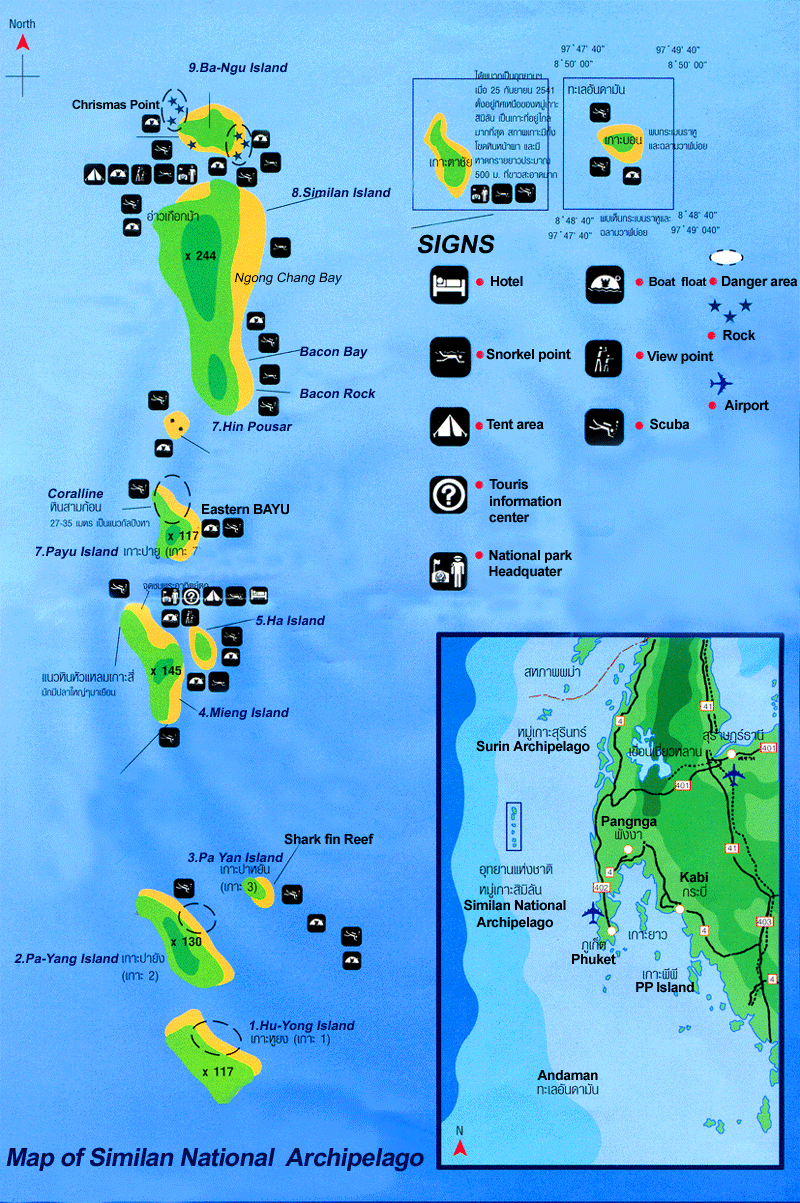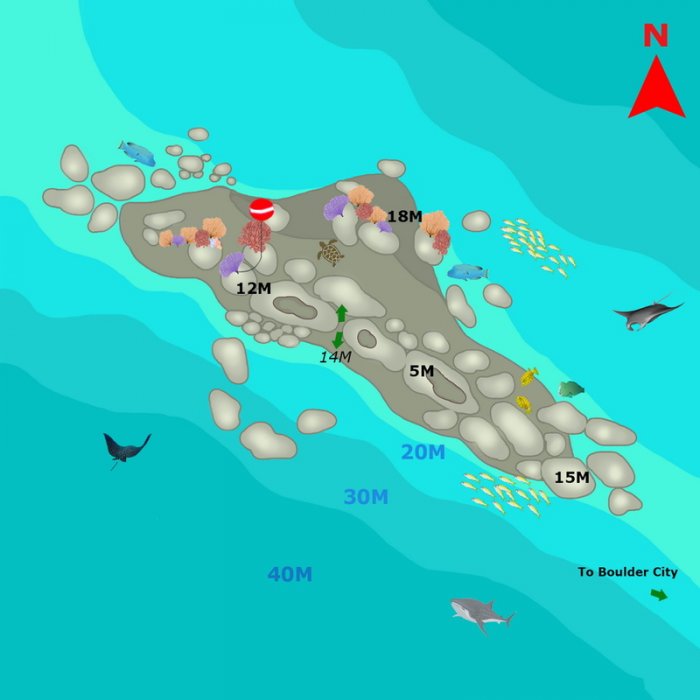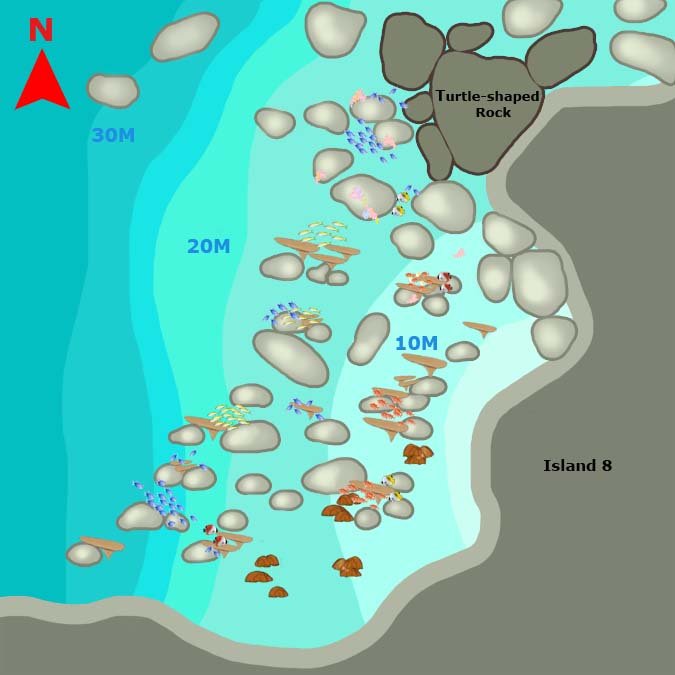
Island 1 – Koh Hu-Yong
The second largest island of the Similan archipelago, located 8 km south of the Island 4. Ko Hu Yong is famous for the largest beach on Similan, which occupies the northwest part of it. However, people are prohibited from entering this beach, as it is a protected area designed to maintain the population of sea turtles. To get to this island, you need to have a special permit. We and you have no reason to receive it, let the turtles lay peacefully without us.
Islands 2 and 3 ― Koh Pa-Yang & Koh Pa-Yan
Both islands are under state protection. Topographically, they are granite mountains with steep banks. None of them have beaches, but there are dive sites.
Shark Fin Reef
It is a rocky formation, about 1 km long, located southeast of Island 3 Koh Pa-Yan. On the surface, it can be identified by three small peaks 5-8 m high, which are almost completely hidden under water during high tides. The dive point, directed from north-west to south-east, consists of giant granite boulders and colonies of hard corals.

The height of the underwater rocks of Shark Fin Reef is 35-40 m. The landscapes of its southern and northern parts differ significantly from each other. A little deeper in the south, the main landscape here is sheer walls covered with soft corals and antlers. Shark Fin Reef is also famous for its underwater tunnels. In calm conditions, with a favorable current and sufficient decompression time, divers swim from one side of the reef to the other in one dive.
Сurrent: moderate to strong, from north to south. At high tide, the current weakens on the north side and increases on the south.
The base of Shark Fin Reef sits on a clean sandy bottom, which attracts leopard sharks, whitetip and blacktip reef sharks, blue-spotted stingrays and garden eels to these places. In addition, this place is one of the few on Similan where you can see Napoleon fish and pineapple parrot fish.

In the shallow waters in the eastern part of the dive point, there are large specimens of box bodies. Among the boulders, you can see camouflaged octopuses and sea ruffs. Like most of the Similan dive sites, Shark Fin Reef is an excellent place to observe large (pelagic) marine fauna: huge tuna, bluefin and giant cranks and flocks of manta rays.
Boulder City
This is a group of underwater boulders located off the southeastern coast of Island 3 Koh Pa-Yan, near the Shark Fin Reef dive point. The underwater peaks are located at a considerable (30-40 m) distance from each other and are hidden at a depth of 12-18 m. The underwater landscape strongly resembles Shark Fin Reef: depth 35-40 m, sandy bottom, soft coral settlements, sea fans and antlers.

Strong current from north to south and vice versa.
Diving on this site is recommended for experienced divers only. First of all, because of the strong underwater current, as well as because of the considerable depth at which the underwater peaks are located.
The marine life of Boulder City also differs little from Shark Fin Reef. There are guaranteed to meet several species of sharks living on the sandy bottom, Napoleon fish, Gumboiled parrotfish, turtles, grouper, snapper, angel fish, unicorn fish, cube box and blowfish. In cracks and under rocky formations live: sea needle, fire arrow fish, dancing shrimp and boxer shrimp.
Island 4 – Koh Miang
The largest island in the archipelago, which houses the offices of the Similan Marine National Park. It is famous for the beaches Haad-Yai and Haad-Lek, located on the northern and eastern parts of the island, respectively. The beaches are connected by a hiking trail through the jungle. Solid romance!
Haad-Lek Beach is a great place to watch long and colorful tropical sunrises. Here you can also meet very beautiful maned (Nicobar) pigeons and “chicken” crabs, which, after eating, begin to make sounds reminiscent of a chicken clucking.

Honeymoon Bay Reef, also known as Haad-Lek, is located directly opposite Haad-Lek Beach. The bay where the dive point is located is ideal for mooring at night. Coral settlements are located here in one line from north to south, smoothly descending from 5-10 m to a sandy bottom 26 m deep. Most of the reef is covered in hard corals such as porites and antlers, but there are also small rocks with soft corals.
Not too deep without strong currents, Honeymoon Bay is great for night dives and trial dives.
Current: calm to moderate north-south flow and vice versa.
The reef is inhabited by many species of small marine life, for example, a cube box, angel fish, butterfly fish, moray eels, as well as a rather rare two-point lion fish in these places. On the outskirts, on a sandy bottom, you can see stingrays and garden eels. After dark, cuttlefish, squid, lobster, decorator crabs, nudibranchs, various reef crabs and several types of shrimp can be seen in the large cracks. Also at this time of day, nurse sharks usually appear, which hunt crustaceans.
Islands 5 and 6 – Koh Ha & Koh Hok
The smallest islands are Similan, located east of Island 4 Ko Miang. Famous for their rich underwater world, especially the garden eel colony.
Anitas Reef, also known as Barracuda’s Point, Hin Muan Deaw, ideal for beginner divers and underwater photographers, suitable for test dives.

The reef is located at the junction of two islands adjacent to each other: it starts in the east of island number 6 and ends in the south of island number 5. The summit is located at a depth of 5-10 m, the total height of the reef is 26-28 m. The landscape is dominated by soft corals and huge multi-colored porites scattered over the white sandy bottom. On the southern side of the reef, giant boulders have formed an underwater tunnel interesting for experienced divers.
A 12×30 m fishing vessel sunk in 2003 was marked with a special buoy. This dive point is called Tuna Wreck. Depth ranges from 28 m at the top of the vessel to 40 m at the bottom.
Current: calm to moderate north-south flow and vice versa.

The shallow depth of the dive site and the sandy bottom create excellent conditions on Anitas Reef for observing the small inhabitants of the underwater world, such as black arrow fish, razor fish, dragon wrasse, angel fish, sea mouse, needle fish, sea ruff and different types of colorful nudibranchs. Spinos, clowns, octopuses and sea snakes are also frequent visitors to the area. During morning dives at Anitas Reef, there is a high probability of meeting with blue-footed carax and snapper, which go hunting at this time of day. In the southern part of the dive point, in the area of large boulders, sometimes large blue-spotted stingrays, sharks and turtles appear.
Island 7 – Koh Pa-Yu
An interesting granite island for divers: in its northern part you can dive among sharp-pointed rocks, in the east – among rocky reefs. The most famous dive points of Ko Pa-Yu are East of Eden and Deep Six, famous for thickets of soft corals and giant sea fans, traditionally attracting underwater inhabitants. Less famous, but no less interesting dive sites are located in the west of the island, while the east side is better for snorkeling.
The East of Eden, also known as Ruan Gluay-Mai, is considered one of the most beautiful in Similan, thanks to the summit called Orchid Garden, covered with colorful soft corals and sea fans. The depth of the East of Eden reef slope ranges from 5 to 40 meters, in its northern part there is an accumulation of antler corals and blue corals. This dive site is well suited for deep diving in the morning or night diving on the flat reef. As a rule, the dive route is laid in a direction from north to south to the left of the reef.It is highly recommended not to dive at the East of Eden during high tide or strong currents.
Current: moderate to strong north-south current.
In the morning on the East of Eden, you can see whitetip and blacktip reef sharks resting on a sandy bottom in the sand, as well as lobsters hiding in crevices.
Along the entire reef, there are many common reef fish and other small creatures such as nudibranch, harlequin pipe-borer, angelfish, sea ruff and flute fish. Groupers like to use the local stones as a shelter. At the middle depth, there are schools of blue-finned carax, monochromatic bonito, yellow snapper and red mullet. There is a chance that during the dive you will come across a green turtle.
West of Eden is a dive point located on the western side of Island 7. Consists of giant granite boulders forming an underwater mountain range with canyons and cliffs. All of this is covered with colorful corals and giant sea fans.

The outer surface of the slope consists of sand and rubble and goes to a depth of 30-35 m. The bottom is covered with stacked granite boulders, on which hard and soft corals, sea fans and sea lilies grow.
Current: moderate to strong from south to north at high tide and vice versa. During high tide, the current may split in some areas, do not forget to clarify this information with the dive guide and take it into account when planning a dive.
This location is ideal for observing sea creatures such as nudibranchs, crabs and frogfish. In small crevices, you can find a variety of needlefish (including the Yanssi igloo), as well as a long-snouted curler, which usually hides in thickets of black coral.
Deep Six – a group of underwater boulders off the northern part of the Island 7, which are its underwater continuation and reach a depth of 35-40 m. Deep Six is home to soft corals and sea fans, and its sheer walls are covered in dense soft corals. This dive point is famous for its underwater tunnels, the walls of some of them are covered with poisonous hydroids, whose thorns should beware.
Current: moderate to strong, especially on the sharpened edge of the reef, where current can carry divers away from boulders. Moves from south-east to north-west, and vice versa.
Not far from the boulders above the sandy bottom, there is a huge number of whitetip reef sharks and blue-spotted stingrays. There are many black and white snappers, giant and blue-finned cranks, neon shooters, yellow perches and tuna. In the underwater tunnels, there is a high probability of meeting a large snapper, an oriental sweet lip and a sweet lip-harlequin, and if you are lucky, then among the underwater peaks, you can see a disguised frog fish and a harlequin pipe nozzle. Lush coral shadows often harbor red fire arrowfishes, blend dogs and nudibranchs. Turtles live among the corals on the shallows.
Island 8 – Koh Similan
The largest and highest island in the Similan National Park. Here is the famous Ao Guerk beach, better known as Donald Duck Bay, suitable for diving and snorkeling. The island is also home to Sail Rock – the most recognizable symbol of Similan. Its observation deck offers a stunning panoramic view.You can enjoy tropical tranquility and silence at Ao Nguang Chang Beach in the eastern part of the island.
Elephant Head Rock, also known as Hin Pusa, Hin Hua-ka-loak, is located 1.5 km south of Island 8 and consists of three huge boulders protruding from the surface. The upper part is shaped like an elephant’s head. Elephant Rock is an incredibly beautiful “underwater skyscraper” standing on the open sea in very clear water. The underwater boulders at Elephant Head Rock are stacked to form sheer walls and tunnels covered in soft coral and sea fans of different shades.
The maximum depth at this dive point is 35-40 m.
Elephant Head Rock is not recommended for snorkeling: because of the great depth (the base of the rock is at a depth of 40 m) it is difficult to see anything from the surface.
One of the features of Elephant Head Rock is the abundance of underwater tunnels, the walls of which are covered with soft coral. Due to the difficulty of the route, only experienced divers can dive here.One of the features of Elephant Head Rock is the abundance of underwater tunnels, the walls of which are covered with soft coral. Due to the difficulty of the route, only experienced divers can dive here.
In the western part of Elephant Head Rock there is a sheer wall extending to a depth of 40 m. Diving at this point should be avoided due to the downdraft, which can cause a sharp rise in water, which is dangerous while being close to cliffs or inside an underwater tunnel. It is recommended to swim through the underwater tunnels in one group so as not to get confused and accidentally damage the corals.
Be careful not to separate from the group as there are strong and often reversing currents. Once you have finished your dive route, swim away from the cliffs and use the diving buoy before starting your ascent.
Current: moderate to strong. At high tide it moves from southwest to northeast, and at low tide, vice versa. You can hide from a strong current on the north side of the boulders, but you need to be extremely careful, as the direction of the current near the boulders often changes. At low tide, the current moves from northeast to southwest.
On the outside of the boulders, blacktip reef sharks are often found, and in the crevices between the boulders, whitetip reef sharks. In the middle layers of the water next to the boulders, there are flocks of bluefin and giant caraxes, archers, rainbow mackerels and barracudas. And in the cracks and grooves you can see a large snapper and a sweet lip. In deep places, you can find a purple fire arrowfish, and near the rocks of a stone wrasse, a clown fish and a blend. Also in some cracks in the boulders live boxer shrimp, doctor shrimp and octopus.

Donald Duck Bay, also known as Ao Guerk, is ideal for diving at sunset or at night. The entry point is located near the underwater peaks at the northern part of the Island 8. During night dives, do not swim through underwater tunnels and disturb fish and animals by touching them or directing the flashlight towards them for too long.
Current: virtually nonexistent as the dive site is in the bay.
After dark, coral crabs, shrimps, squid, nudibranchs and large lobsters that hide in the ledges come to life on Donald Duck Bay. Coral fish sleep along coral reefs, while parrotfish sleep in slimy cocoons. There are also groupers, hunting nurse sharks and a variety of sea turtles that occasionally ask scuba divers for food. It is strictly forbidden to feed them, as in the long term it can change their natural behavior and ability to survive.
Turtle Rock, also known as Hin Tao, is a coral group on a rocky coastline and isolated reef located west of Donald Duck Bay near Island 8. The visiting card of this place is a rock, shaped like a turtle. Turtle Rock consists of stacked stones, and thickets of antlers coral. The sandy bottom is at a depth of 25 m, and the average depth of the rocky area is 15-20 m, to the north of which there is a shallow 8-10 m deep, where there is also an underwater tunnel.

Current: mild, north-south direction and vice versa.
The sandy bottom attracts blue-spotted stingrays and garden eels. Snappers, groupers, angelfish, moray eels and several types of sweet lips are found in the crevices of the rocks. It is also home to nudibranchs, squat lobsters and turtles.
Waterfall Bay is a small bay located south of Turtle Rock. The average depth of the dive site is 10-15 m, maximum 20 m, it is famous for an abundance of hard coral species such as porites, antlers, table coral and brain coral. The northern part of the bay is made up of large rocks and soft corals that stretch all the way to Turtle Rock. Due to the calm current, shallow depth and the possibility of night mooring, this place is ideal for night dives.
Current: calm to moderate north-south flow and vice versa.
Waterfall Bay is home to many species of coral fish and sea turtles. Large lobsters, coral crabs, porcelain crabs, boxer shrimps, nudibranchs and flatworms are encountered at night. Sometimes you can see nurse sharks.

Island 9 – Koh Ba-Ngu
The island is very popular with divers. It is known for its pointed underwater rocks (pinnacles) and a large concentration of corals living on its northern and eastern sides. Best dive sites in Koh Ba Ngu are Christmas Point and Rocky Point.
SIMILAN ISLANDS: A DIVER’S PARADISE AND BEYOND
SIMILANS – RICHELIEU ROCK DIVE SITE
SIMILANS – KOH TACHAI DIVE SITE

